Akhal Teke

The Akhal-Teke is a horse from Turkmen, in the southern region of the modern country of Turkmenistan. These horses have been renowned as cavalry mounts and racehorses for some 3,000 years. The Akhal-Teke has superb natural gaits, and is the outstanding sporting horse from this area. The Akhal-Teke is native to an arid, barren environment. During its history, it has established a reputation of great stamina and courage. A key to the Akhal-Teke’s stamina is its diet which is low in bulk but high in protein, and frequently includes butter and eggs mixed with barley. Today the Akhal-Teke is used in show jumping and dressage in addition to daily use under saddle. The Akhal-Teke's conformation can be favorably compared to the Persian Arab, another breed of ancient origin. Its head is similar to the Arab's, being long and light with expressive eyes. It has relatively long ears and a long neck. It has a short silky mane, or none at all, and a short tail. This breed has a narrow chest, long back, and flat ribs. The legs are long and slender, clearly revealing the tendons. It averages 15-15.1 hands in height. It is often dun in color, although it can be bay and gray, with a pale golden coat preferred. The Akhal-Teke is among the most elegant of the world's
Albanian

The ancient inhabitants of this area were Illyrians, Indo-Europeans who overran the northwest part of the Balkan peninsula around the fifth century B.C. The Serbians settled here during the seventh century A.D. and were overpowered by the Turks in 1386. During the Ottoman Empire, a great deal of Arab blood was infused into the local horses, which were likely various combinations of Tarpan, Turkmenian, and Mongolian stock. The Albanian knighthood of Skanderbeg was a rear force for this national hero, terrifying the Osman invaders (Ottoman Empire) and bringing honor and glory to the country.
The Albanian is known for its freedom of movement, agility in difficult terrain, disease resistance, and endurance. In the past these horses were used more for transport and riding than for agricultural purposes. In the early 1990's, measures were taken to promote and increase the number of Albanian horses and to improve them for agricultural work. The improved breeds are concentrated in large breeding centers such as the Zootechnic Station at Shkodra and at specialized farms where stallions are produced for improving local horses. Since 1980 there has been a great increase in the number of horses in Albania. The Myzeqea is very good for long distance use and is exceptionally strong for its size and many have an easily ridden ambling gait. The Albanian are hardy efficient horses. They are often used as carriage horses as well as for riding and light draft.
The goals of Albanian breeders today are concentrated increase in number and improvement. Purebred Arab, Nonius, and Haflinger horses are crossed with the native Albanian and several improved types are emerging. The native horse of Albania has few disadvantages of quality, the main need being increased size for better agricultural work. The Haflinger breed was imported from Austria to help improve the working abilities of horses in the hilly regions of the country.
American Cream Draft
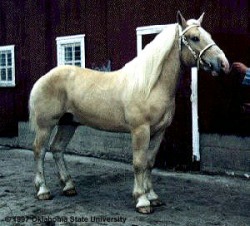
'Old Granny' the first known American Cream, appeared at a farm sale in Story County, Iowa, in 1911. By approximation, her foaling date was somewhere between 1900 and 1905. She appeared to have nothing but draft breeding in her bloodlines. A veterinarian, Eric Christian, was very much attracted by the beauty of her foals and persuaded Nelson Bros. of Jewell, Iowa, to keep a colt, Nelson's Buck, for a stallion, and create a new breed of horses having rich cream color, white mane and tail, pink skin and amber colored eyes. Records gleaned from early registrations confirm that 'Old Granny' was mated to Belgians,, Percherons, Greys, Dunns, Sorrels, all being of draft bloodlines and often the rich cream, pink skin, white mane and tail and amber eyed foals were dropped. The stallion having the greatest influence on the American Cream, Silver Lace, was foaled in 1931 out of a Farceur Belgian mare and Knox. Silver Lace had a narrow blaze running down his face. At maturity he was 16 hands and weighed 2,230 pounds. Knox as foaled in 1926 by a bay grade Shire mare out of Yancy. Yancy, the only son of Nelson's Buck to be registered, was foaled in 1923 to a black Percheron mare. Nelson's Buck, the first known stallion out of 'Old Granny' arrived in the spring of 1920. Though sired by a black Percheron, he was just as cream-colored as 'Old Granny' his dam.
American Walking Pony

Have you ever seen a dream walking. . .Well, we have! It was a beautiful Spring day, May 10, 1968 , a newborn golden palomino colt galloped up the hillside at the Browntree Farm beside his proud mother, a glittering liver chestnut. This colt was the product of years of experimental crossbreeding to produce a large pony around 14 hands in height with Arabian type and smooth saddle gaits.
Dream Come True, the Perfect Pony was named BT Golden Splendor and has thrilled spectators at horse shows with his incomparable gaits, golden color, flowing long mane and raised tail carriage.
In the Fall of 1968, the American Walking Pony Registry as established with the breed's founder, Joan Hudson Brown serving as Executive Secretary. Registration Number 1 went to Browntree's Flicka, a mare instrumental in the development of the breed. BT Golden Splendor was assigned Number 5 and is the first stallion registered in the breed.
After the American Walking Pony was featured in articles in various horse magazines, horse lovers from around the world expressed interest in purchasing breeding stock.
The foundation cross that produced the American Walking Pony was the Reg. Tennessee Walking Horse and the Reg. Welsh Pony. The Walking Horse contributed the smooth saddle gait and the Welsh, the lovely head and long arched neck. Ponies of various bloodlines of this cross were accepted for registration.
Andalusian

The Andalusian horse has been highly regarded since the Middle Ages. Also the Andalusian, has officially been known as the Purebred Spanish Horse, reigned for several centuries throughout the known world as the embodiment of perfection in horseflesh. The Andalusian is represented by the names Iberian Saddle Horse, Iberian War Horse, Jennet, Ginete, Lusitano, Alter Real, Carthusian, Spanish Horse, Portuguese, Peninsular, Castilian, Extremeno, Villanos, Zapata, and Zamaranos. Spanish horses have been esteemed for their quality and appearance since Roman times. The Moors invaded Spain in the Seventh Century and brought Barb horses with them. These oriental horses were crossed with quality native Spanish stock, and the result was the Andalusian. In the Middle Ages, the Andalusian was the favored mount for European nobles. The Andalusian was a major influence on the Lipizzaner breed in the 1500's. More recently, it was used as a cavalry mount. Its numbers at one time diminished, but today the Andalusian's physical appearance and flashy action make it one of the world's most desirable riding horses. The Andalusian has a distinguished appearance, usually appearing in the colors white and light gray, and occasionally bay. It is a compact horse with excellent proportions, and usually stands at 15.2 hands. The mane and tail are abundant. It has a flat or slightly convex nose, small ears, and its head is set on a substantial neck. The chest is quite massive and the quarters are lean. The legs are clean and the action is quite energetic. The Andalusian is renowned for its ability to learn and its superb temperament.
Anglo-Kabarda

This breed was created in the northern regions of Caucasus in Russia by crossing Kabarda mares with Thoroughbred stallions at the Malokarachaevski and Malkin studs. the bay stallions Lestorik (1939) and Lukki (1939) and the dark bay stallion Lok-Sen (1923) were of particular importance in development of the breed. The Thoroughbred breeding comprises from 25 to 75 percent in the present day Anglo-Kabarda breed.
Anglo-Kabarda horses are well suited to the climate of the Caucasus, thriving at pasture the year round and are able to negotiate difficult mountain terrain skillfully. At the same time, they are much larger and faster than the purebred Kabarda, and the conformation is more like that of the Thoroughbred.
The Anglo-Kabarda horses participate at national and Olympic events and are used as saddle mounts on farms of the northern Caucasus.
Appaloosa
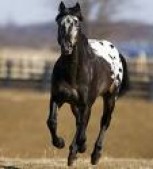
The Appaloosa's heritage is as colorful and unique as its coat pattern. Usually noticed and recognized because of its spots and splashes of color, the abilities and beauty of this breed are more than skin deep.
Appaloosas are found in nearly every discipline. Setting speed records on the race track, excelling at advanced levels of dressage, jumping, games, reining, roping, pleasure, endurance and as gentle family horses - any of these roles can be filled by the versatile Appaloosa. Their eager-to-please attitudes and gentle dispositions make them a pleasure to work with in any area.
Humans have recognized and appreciated the spotted horse throughout history. Ancient cave drawings as far back as 20,000 years ago in what is now France depict spotted horses, as do detailed images in Asian and 17th-century Chinese art.
The Spanish introduced horses to North America as they explored the American continents. Eventually, as these horses found their way into the lives of Indians and were traded to other tribes, their use spread until most of the Native American populations in the Northwest were mounted (about 1710).
The Nez Perce of Washington, Oregon and Idaho became especially sophisticated horsemen, and their mounts, which included many spotted individuals, were prized and envied by other tribes. Historians believe they were the first tribe to breed selectively for specific traits - intelligence and speed - keeping the best, and trading away those that were less desirable.
When white settlers came to the Northwest Palouse region, they called the spotted horses "Palouse horses" or "a Palouse horse." Over time the name was shortened and slurred to "Appalousey" and finally "Appaloosa."
Arabian
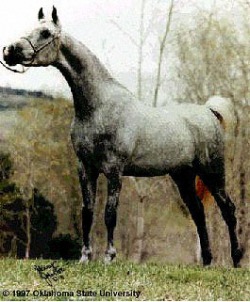
The Bedouin tribes of the desert, believing the horse to be a gift from God, told many romantic tales of the Arabian's beginnings. One such legend claims God fashioned the desert south wind into a creature who "shall fly without wings". No matter how the horse came to the desert, Bedouins took them as prized members of their households. Individual horses were selected for the gentle, affectionate nature, the striking look and proud spirit the breed is known for today. The Arabian was also bred to withstand long treks across the desert and the tribal wars which sometimes followed such trips. The Bedouins developed horses with strength, courage and stamina required for survival, and for the speed and responsiveness needed to win the tribal skirmishes. All in all, the Arabian Horse developed a significant list of attributes!
When Europeans sought to improve their saddle horses, Arabians were imported to cross with native strains. The standard procedure was to use purebred Arabians, especially stallions, to improve stock. The Byerly Turk, Darley Arabian and Godolphin Arabian are conspicuous in English Thoroughbred pedigrees. Similar improvement plans took place in France, Germany, Spain, Poland, Hungary, and Russia. Today, Arabians are found throughout the world and the blood of Arabians flows in all breeds of light horses.
Ardennes
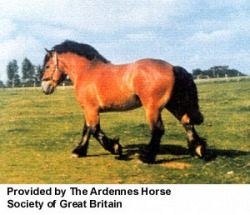
The Ardennes is thought to be descended from heavy draft horse praised by Julius Caesar in De Bello Gallico. Ancestors to the breed are thought to have been bred on the Ardennes plateau for 2,000 years. The breed was valued by Napoleon for its endurance. The Ardennes is among the oldest of the European heavy draft breeds. During the eighteenth century, Arabian reeding was introduced into the breed and more recently Belgian Draft blood was used to increase size and strength of the animals. The Ardennes is a lighter, mountain bred, version of the Belgian Draft orse. It was used in creating the Baltic Ardennes, Russian Heavy Draft and Swedish Ardennes. They may be bay, roan, chestnut, gray or palomino. Black is excluded from registration and is very rare.
Asturian
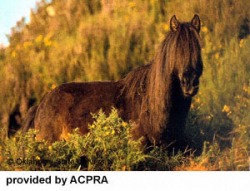
Centuries ago the existence of a small horse breed originating in the northwest of Spain was recorded. The Romans referred to these horses as asturcons and thought well of them - and they were popular with the French during the Middle Ages. Pliny (23-79 A.D.) described them as a small breed that did not trot, but moved in an easy gait by alternately moving both legs on one side. The ambling gait was natural for this small horse, and done in such a way that it gave a comfortable ride. As a result, they become popular as ladies' mounts. Known as palfreys in England, they were called haubini in France, a word that later became hobbye and eventually hobby horse. Much of this blood was taken to Ireland, where the "Irish Hobby" was greatly admired.
It is thought by some that the Astrurian developed as a cross between the Garrano pony of northern Portugal and Spain - a direct descendant of the Celtic pony - and the Sorraia, the original saddle horse of Iberia, which gave the breed its calm temperament. Some other blood must have been present in the Astrurian's lineage, however, because the ambling gait is not present in either the Sorraia or Garrano. Suspected by the author is a strong and more direct link to the ancient Celtic pony, of which some strains at least must have been amblers. There is a narrow but clear trail of ambling horses to be found in Turkey, China, Mongolia, and Siberia, tracing the route of the prehistoric horse to the now submerged land-bridge at the Bering Straits. Living in a feral state for the most part, under difficult conditions, the breed was facing extinction. The predominant colors for the Asturian is black or bay with no white markings. The Asturian has a small although sometimes rather heavy head, with a straight profile, small ears, and large eyes; the neck is long and quite thin with a flowing mane; the withers are moderately high; the back straight and strong; the croup is sloping with a low tail-set; the shoulder is well sloped. The feet of this pony are well shaped and very tough.
Azteca
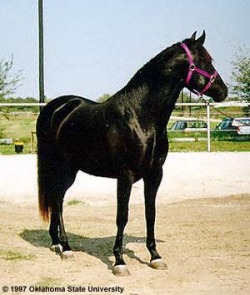
The Azteca breed was the first breed developed in Mexico. Horses of Spanish blood have always be favored in Mexico and in 1972 development of a breed using Andalusian, Quarter Horse and Criollo began. Don Antonio Ariza, President of the house of Pedro Domecq worked with tenacity and patience, and managed, with the help of many other individuals, to realize the dream that Mexico have its own national breed. The Mexican Department of Agriculture granted official registry to the Azteca breed on November 4, 1982. Don Antonio imported Spanish Andalusian horses and began to breed them at Rancho San Antonio near Texcoco in the state of Mexico. Selection for the Azteca breed began by the crossing of these Spanish Andalusian stallions with Quarter Horse mares or alternatively the crossing of Andalusians with mares of mixed Criollo blood. The Azteca may have a minimum of 3/8 to a maximum of 5/8 Andalusian or Quarter Horse blood, while the percentage of Criollo may not exceed 1/4. The breed aims at blending the qualities of the Andalusian and Quarter Horse. The result is an elegant animal, ideal for performance or pleasure riding
Banker (Shackleford)
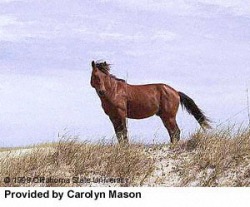
The Banker Pony stands about 14 hands and is a semi-feral breed that originated on the Outer Bank Islands of North Carolina, including Shackleford Island which is only nine miles long. They are thought originated from Spanish horses since the 16th century.
Barb
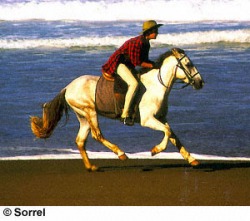
The Barb is a light riding horse which originated in the Maghreb region of northern Africa. There are several varieties including Algerian, Moroccan and Tunisian. This is the foundation breed of the West African Barb and the Spanish Barb hich was developed in the United States.
Bashkir
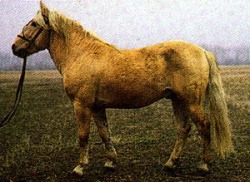
The Bashkir is a small, wide-bodied and bony horse. It has a massive head and a short and fleshy neck. The withers are low, the back erect and broad, the croup nicely rounded, the ribs long and well sprung, the chest broad and deep and the legs short and bony. The mane and tail are thick.
The average measurements (in cm) are: stallions - height at withers 143, oblique body length 144, chest girth 180, cannon bone girth 20; mares: 142, 145, 178 and 18.5 respectively. The most widespread colors are bay, chestnut, roan and mouse grey.
Basotho Pony

The Basotho Pony is found in Lesotho, which is an enclave of South Africa. It is used for exclusively for riding and only cattle are used for draft purposes in Lesotho purposes. The Basotho Pony was developed from the Cape Horse during the period after 1825. By the early 20th century the breed has almost disappeared due to exportation and crossing with Arab and Thoroughbred horses. During the latter part of the 20th century a breed society was formed to revive the breed. In addition to the walk, trot and canter, the Basotho as two additional gaits, the tripple and pace.
Belgian Heavy Draft (Brabant)
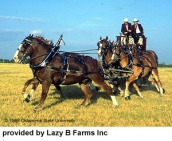
The Belgian, as the name implies, is native to the country of Belgium. This little country is blessed with a fertile soil and abundant rainfall providing the thrifty farmers of Belgium with the excellent pastures and the hay and grain necessary to develop a heavy, powerful breed of horse.
Belgium lies in the very center of that area of western Europe which gave rise to the large black horses known as Flemish horses and were referred to as the "great horses" by medieval writers. They are the horses that carried armored knights into battle. Such horses were known to exist in that part of Europe in the time of Caesar. They provided the genetic material from which nearly all the modern draft breeds were fashioned.
Stallions from Belgium were exported to many other parts of Europe as the need to produce larger animals of draft type for industrial and farm use was recognized. There was no need to import into Belgium for she was the "mother lode." It remained only for this ancestral home of the "great horse," by whatever name, to refine and fix the type of the genetic material she already had at hand.
Breton
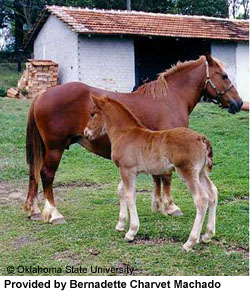
The Breton horse originated in France. It is used for heavy draft and farm work. It stands 15 to 16 h.h. The Breton horse has a long history with many differences in opinions. It has been said that the breed dates back four thousand years or more to the time it was brought into Europe by Aryans migrating from Asia. Others have said that the breed comes from smaller horses that were bred and improved by Celtic warriors on their conquest of what is now Great Britain. A population of horses ridden by the Celts that were probably descendants of the steppe horses were found in the Breton Mountains for many years. At the time of the Crusades, these horses were bred to Oriental stallions and mares, leading to the Bidet Breton. Two types of Breton horses existed at the end of the Middle Ages. They were a northern Brittany pack horse called the Sommier and the Roussin, meaning cob, which originating from the Mountain Bidet that is finer and more slender than the Sommier. The Bidet Breton was wanted by many military leaders during the Middle Ages due to its comfortable gait, which is said to be between a brisk trot and an amble. Many crossbreeds were also made in the following centuries in order to meet the needs of production to the economic needs of various periods.
Camargue
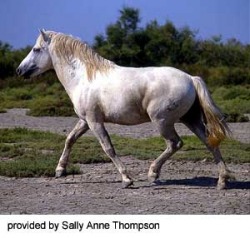
Some say that the Camargue horse has an oriental or Saracen origin, due to the forsaking of Arab horses uring the barbaresque invasion in the south of France in the 8th century. We can presume that those horsemen only rode males, not females. So, if crossings have been done, they were absorbed into the local horses.
According to some scientific research, the origin of the Camargue horse would be the solutre horse, who lived in a marshy land, near the Quanternary Sea. Both have the same characteristics (same skeleton, same stature...) From his cradle, they went down to the Rhone Delta. So, we can admit that the foreign crossings had no influence on the present Camargue horse and that he's really the descendent of the solutre quaternary horse, with the same characteristics, thanks to the deep and permanent action of the environment in which he lives in half-liberty.
Canadian Horse
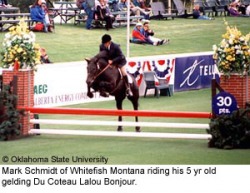
The Canadian Horse is a little known national treasure of Canada. This hardy breed descended from horses originally sent to the “New World” by King Louis XIV of France in the late 1600’s. These Norman and Breton horses were felt to be of Arab, Andalusian and Barb ancestry – traits of which can still be recognized in the Canadian Horse today.
For hundreds of years, the French horses bred with little influence from outside breeds. They eventually developed into their own distinct breed - the Canadian Horse or Cheval Canadien. Because they evolved under the adverse conditions of harsh weather, scarce food, and hard work, the Canadian Horse remains the sturdiest and most acclimatized horse in Canada today. They are tough, strong horses, tolerant of inclement weather conditions, and are extremely “easy keepers”. Because of these traits, the Canadian Horse is often referred to as “The Little Iron Horse”.
Caspian
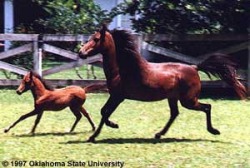
The Caspian is an ancient breed previously believed to have been extinct for over one thousand years. This breed is probably the most direct ancestor of the Oriental breeds and subsequently of all light horse breeds.
The Caspian is extremely rare and barely pulled back from the edge of extinction in 1965. It is now being studied by leading archaeozoologists to prove the link between the modern Caspian and the tiny prehistoric horse of Persia.
Louise Firouz, an American living in Iran, is credited with recognition of this ancient breed.
The Caspian head is short and fine with large eyes, a small muzzle, and large nostrils placed low. There is a pronounced development of the forehead, the ears are very short; the neck is slim and graceful, well attached to sloping shoulders; withers are pronounced; the back straight; and the tail set high on a rather level croup. The legs are slim with dense, strong bone and no feathering at the fetlock. The hooves are extremely strong and oval-shaped, more like those of the ass than the horse. The overall impression of the Caspian is that of a vary small, well-proportioned horse. Subsequent studies confirmed the visual picture osteologically; the Caspian is a miniature horse, not a pony. The color ranges from bay, gray, or chestnut and occasionally black.
Chincoteague Pony
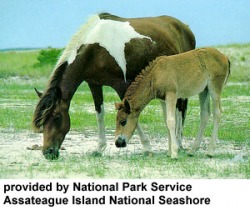
The Chincoteague Pony, now a registered breed, descends from the 'wild' horses on Assateague Island, a 37 mile long barrier island off the coast of Maryland and Virginia.The 'wild' horses on Assateague are actually feral animals, meaning that they are descendants of domestic animals that have reverted to a wild state.
Despite the often told tale of the horses swimming to Assateague from a shipwrecked Spanish galleon, the most plausible explanation is that they are the descendents of horses that were brought to Assateague in the 17th century by mainland owners to avoid fencing laws and taxation of livestock.
Today's horses are actually the size of ponies (average 12- 13 hands) probably due to their poor diet and harsh environment. Some horses removed from Assateague as foals and fed a higher protein diet grow to horse size. Almost 80% of their diet is coarse saltmarsh cordgrass and American beachgrass. Various grass species, greenbrier stems, bayberry twigs, rose hips, seaweeds and poison ivy make up the rest of their diet. The high concentration of salt in their diets causes the horses to drink twice as much fresh water as domestic horses. Because of this, the horses have a "fat" or "bloated" appearance. Although they will sip salt water, they drink very little of it
Cleveland Bay
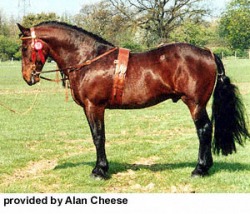
The Cleveland Bay is the oldest established breed of English Horse.
In 1884, the Cleveland Bay Horse Society of Great Britain published the first volume of its Stud Book containing stallions and mares scrupulously selected for purity of blood, many of whose pedigrees traced back over a century. Since that date, the breed has been maintained free of outcrosses. In consequence, Cleveland Bays stamp their get with remarkable uniformity of size, conformation, soundness, stamina, disposition and color.
Clydesdale

As in all breeds of livestock, the Clydesdale has gone through several changes of emphasis, over the years, to meet the demands of the times. In the 20's and 30's the demand was for a more compact horse; of late, it has been for a taller, hitchier horse. Most of the horses range in size from 16.2 to 18 hands and weigh between 1600 and 1800 lbs. Some of the mature stallions and geldings are taller and will weigh up to 2200 lbs. With the changes in the size and type of horse wanted, the Clydesdale emphasis on underpinning has remained paramount.
The most common color in the Clydesdale breed is bay. Black, brown, and chestnut are also seen with roans (solid body color with white hairs throughout the coat) in all of the colors. The preferred markings are four white socks to the knees and hocks, and a well-defined blaze or bald face. The show ring does not discriminate on color with light roans and horses with dark legs being considered equally with horses of the more solid colors and traditional markings. The increased popularity of big hitches has directed more attention to color in recent years and the stabilization of color patterns.
Colorado Ranger
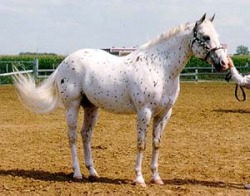
The Colorado Rangerbred was named for its Colorado High Plains origin. Despite appearances, the Rangerbred is not a type of Appaloosa. It has its own unique heritage. However, many Rangerbreds are double-registered with the Appaloosa Horse Clubs of both the United States and Canada. There is a one in ten chance that an Appaloosa is a "Lost" Rangerbred.
The Rangerhorse was bred for cow savvy and performance capabilities.
The Colorado Ranger Horse Association has no color preference. Some of CRHA registered horses display Appaloosa Characteristics and coloration and some do not. “Color is a fickle jade. It is merely pigment in the skin. It cannot be ridden. Fads fade. Bloodlines endure.”
To meet registration requirements, a horse’s lineage must trace directly to the foundation sires: Patches #1Z and/or Max #2Z. Patches (a direct descendant of Leopard & Linden Tree-horses given to Ulysses S. Grant by the Sultan Abdul Hamid of Turkey) was purchased from the Whipple Ranch. Max (a son of the renown Waldron Leopard) came from the Governor Oliver Shoup ranch at Colorado Springs.
Connemara Pony
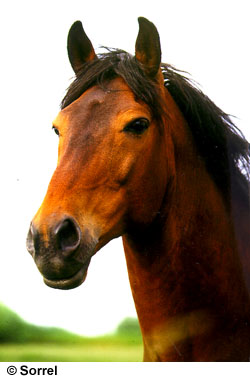
Legend has it that the Connemara Pony descended from Spanish horses, rescued from the Armada when the ships wrecked on the rocky coast of western Ireland in 1568. In fact, the Connemara’s ancestors lived in Ireland for thousands of years, although some of the Armada's horses may have mated with local stock. It is certain that Thoroughbred and Arabian blood was introduced in the 1700's. By the 1920's the breed was threatened by random breeding and the Connemara Pony Breeders Society was formed to preserve the purity of the breed. A key to the excellence of the Connemara Pony is the hardy environment in which it lives. Turned out to survive the harsh weather on rough pasture, only the strong of the breed survive.
The body of the Connemara is compact and deep, yet not bulky. It has legs which are short, clean, and have ample bone; the shoulders are rounded. The Connemara has a handsome head, the neck fairly lean, and it has abundant mane and tail. The Connemara stands between 12.2 and 14.2 hands. In spite of its relatively small size, the Connemara is known as an excellent hunter and jumper, and it competes in such varying events as distance riding and dressage. The Connemara was originally dun in coloring, but this color is now rare. It is most frequently found gray, but also in black, bay, and brown.
Dartmoor pony
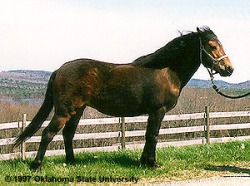
The Dartmoor Pony is one of nine breeds native to the British Isles. The area from which it originates is a rocky, barren, moorland called Dartmoor in Devon, England. The sparse grazing and bleak conditions of this moor ensure that only the toughest of its inhabitants thrive.
Dartmoor Ponies have roamed the moor for many centuries. One of the earliest recorded references to these ponies is in the will of a Saxon Bishop, Awlfwold of Crediton, who died in 1012. During the reign of Henry I (1100-1135), when Dartmoor was a royal forest, a stallion was taken from the moor and was used breeding with the royal mares. Many years ago, tin mining was an important industry in the Southwest of England. Many Dartmoors were used as pack ponies, carrying the tin from mines to the surrounding towns. When the mines closed, most of the ponies were turned loose to roam the moor, except for a few retained by local farmers for use on the farms. At the start of the Century, officials from the High Security Dartmoor Prison, situated in Princeton, a town in the middle of the moor, were raising good quality though unregistered ponies. Prison guards would use the ponies when escorting work parties to and from the prison. This continued until the 1960's.
Døle
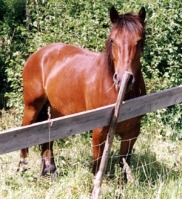
This breed originated in the Gudbrandsdal valley, which connects to the Oslo region situated on the North Sea coast. It is likely that the Friesian played a part in the breeding of the Døle due to the similarity between the two. The Friesians traded heavily with Britain, Norway and the Rhine Delta during the period from 400 to 800 A.D. The Døle horse of today is found in two types. A heavy work horse and a light draft horse, the cold-blooded trotter. The difference between the two types has been greatly reduced in recent years due to interbreeding between the types. This interbreeding is now becoming very common and the breed is becoming very uniform. The heavy type of Døle are tested for pulling power and trotting when presented for grading. X-rays of the knee and lower leg are taken in lighter trotting type, and animals with defects are disqualified for breeding. Stallions of this must have achieved satisfactory results on the track before being used as a stud. Three year olds may be issued a temporary stallion license if their conformation, breeding and trotting ability are acceptable. Quality of the Døle has improved during the last several years due to the organized selection of breeding stock.
Dutch Warmblood
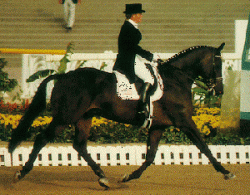
The Dutch Warmblood is a "warmblood sport horse" breed. Warmblood simply distinguishes this type of horse from the "cold bloods" (draft horses) and the "hot bloods" (Thoroughbreds and Arabs). Sport horse refers to the intended use of the breed - as a competitive and recreational horse for the major international equestrian disciplines of dressage, jumping, 3-day event, and driving.
Eqyptian Horse

The Egyptian is a light riding horse of the Arab type found in Egypt. The herdbook for the breed was formed in 1900.
Exmoor Pony
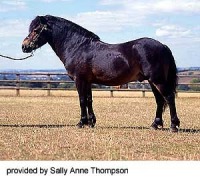
The Exmoor pony is the oldest and purist of the British native pony breeds. The ponies have roamed the bleak, open moors of southwestern England, known as Exmoor, for centuries. They are believed to be the direct descendants of the horses that walked onto Britain before it was an island. Archaeological evidence dating back over 60,000 years bears an uncanny similarity to the Exmoor Pony of today.
Natural selection has designed a pony suited to survival in a cold and wet climate without the provision of food or shelter by mankind. Two features unique to the breed are the “hooded-eye”, or heavy upper brow to protect the eyes from wind and rain, and the “snow-chute”, a group of short course hairs at the top of the tail designed to channel rain and snow down away from the body. The snow-chute, or ice-tail is shed each summer and regrown each Autumn. Their summer coat is sleek and shinny, but in winter they grow a double layered coat to provide both insulation and waterproofing enabling them to stand out in the worst of weather and remain dry at skin level. Exmoors are always brown with black points and show the characteristic mealy or buff colored ring around the eyes and muzzle. The forehead is very broad, the eyes large and pronounced, the ears small and the jaw deep. The body is deep and the ribs well sprung. The legs are short and clean with well developed joints and ample bone. The hooves are neat, hard, and well shaped. Their action is straight and true, showing no tendency to animation or sweeping. The preferred height range is 11.3 to 12.3 hands for stallions and geldings, and 11.2 to 12.2 hands for mares. Ponies weigh on average 700-800 pounds. The general appearance is that of balance, strength and definite pony character.
Farabella
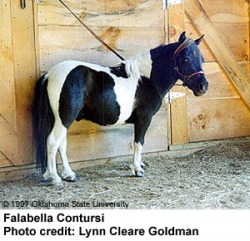
The origin of the Falabella horse can be linked to the origins of a horse in Latin America called the Andalusian horse that the Spaniards brought with them to accomplish the enormous task of the conquest--chosen for their rusticity and resistance. They were later left to survive on their own due to unsuccessful attempts to conquer the area's human inhabitants. The name comes from the family who developed the breed in the middle of the nineteenth century.
Wandering without destination over the vast plains ("pampas"), the surviving horses underwent by necessity a series of biological processes and structural changes in order to adapt to the new conditions that were incredibly different from those of their native land.
The horses were forced to move great distances to find water and pasture due to the strong sun, cold southwestern winds ("El Pampero"), fierce storms and aridity of the land. This gave them incomparable resistance. Their keen instincts and ability to sense danger were sharpened by the persecution from humans and four legged predators.
These factors, in addition to continuous inbreeding and isolation, probably caused genetic mutations in successive generations, resulting in the kind of horse that the ancestors of the Falabella family are said to have seen for the first time before the mid-nineteenth century in the herds of Mapuche Indians of southern Buenos Aires province in Argentina
Fell Pony
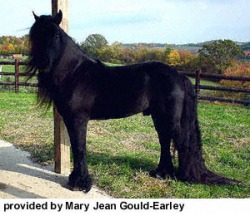
One of the classic native breeds of England, the Fell Pony is noted for its hardiness, courage and adaptability. Its docile temperament makes it popular with riding and trekking stables, and it is also well suited for driving, is a creditable jumper and has the ability to trot for long distances at a steady speed. Bred for the harsh environment of England's north country where feed is always at a premium, the Fell requires less keep than most horses and ponies, and given sufficient shelter, will live out in all weather. Generally, the native breeds were named after-their local habitat and in relation to the work for which they were bred ... thus the name "Fell" or hills.
The Romans, in their endless search for conquests, first landed on the shores of Britain around about 55 B.C. A considerable number of Friesian horses were imported into the north of England either by the Romans or by mercenaries in their employ. Eventually when the Romans withdrew from Britain to go to the aid of their besieged home city of Rome, they left behind about one thousand Friesian horses, most of which were stallions, and which were bred with the native ponies. From these not only the Fell was bred but also the Old English Black (now merged into the Shire Horse) and the now extinct Galloway and Fen ponies.
Fjord
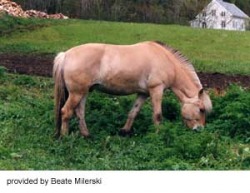
The Norwegian Fjord (pronounced Fee-ord) Horse is Norway's oldest horse breed. It is estimated that the original Fjords migrated to Norway and the Scandinavian peninsula over 4,000 years ago and they were domesticated about 2,000 B.C. They have been selectively bred in Norway for over 2,000 years and the first directed selection program began in the mid-1880's. The original Norwegian Fjord varied in color and averaged 12.1 hands in size. Selection has increased the height to 13 to 14.1 hands and the breed is one of the few modern breeds exhibiting only the primitive or dun coloration.
This pony was used by the Vikings for war mounts and they were also thought to be the first western Europeans to use horses for farming and the horses they used were the versatile Fjord pony. It is thought that all present-day draft breeds in western Europe are descended in part from the Norwegian Fjord.
Friesian
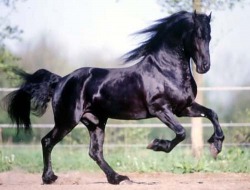
One of the outstanding characteristics of the Friesian horse is its very long mane and tail. These are never cut and often reach the ground. The breed also has abundant feather and long leg hair reaching from the middle of the leg. The color is always black, and only a white star in the forehead is permissible. The head of the Friesian is carried quite high and the face is expressive. The neck is carried rather vertically and is low-set. The legs and quarters are muscular yet smooth. It stands at 15 hands and has an excellent disposition. The Friesian is an old breed of horse dating from the Middle Ages. Its location of origin is Friesland in the northern Netherlands. The breed nearly died out before World War I and has since been revived as a fine carriage horse. The horse is now being exported to other countries and its popularity is growing.
Galiceño
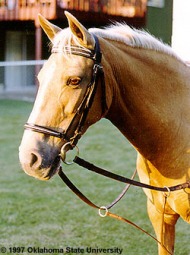
The Galiceño was introduced to the United States in 1958 making it relatively new. The Galiceño has been in the New World since the Spanish conquistadors brought horses to the continent in the early sixteenth century. The Galiceño descended from the Galician of northern Spain and the Garrano of Portugal. It was among the first sixteen horses landed by Hernando Cortes when he invaded Mexico from Cuba in 1519.
Prized for its intelligence, beauty, smooth gaits, and endurance, the Galiceño became the cherished possession of natives in the coastal regions of Mexico. Although they were in part ancestors to the mustangs, the Galiceños have never migrated north to join other equine breeds in the United States, until recent interest started the importation. The Galiceño is usually used as a child's pony due to its small size, although the Galiceño is well able to carry a man all day in rough country. Galiceños are extremely gentle in nature and easy to handle. With such good disposition they are an excellent family horse. From the time of the conquistadors the Galiceño has performed conceivable tasks and has accomplished each with a remarkable native intelligence. The Galiceño is bright, alert, and very quick to learn. It shows its worth to the novice and expert alike
Gotland

The herd of ponies at Lojsta moor on the island of Gotland is unique. The Gotland pony, or Russ, as it is called in Sweden, has been called a living relic of the past, and that is precisely what it is. Thanks to decisive intervention on the part of the local inhabitants, Sweden's most primordial horses still live as they have for thousands of years on the wooded moors of Gotland.
The Gotland Pony horses have lived in the forest regions of the island of Gotland from time immemorial. Their history is mysterious and fascinating. Discoveries from the Stone Age show that horses have been present on Gotland for 4,000 - 5,000 years, and perhaps longer. It is not known whether these horses were Gotland Ponies, nor is it known how the first horses came to the island.
Gypsy Vanner
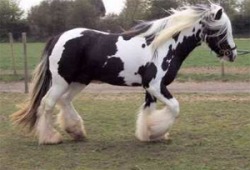
These horses, bred by the Gypsies, are easily recognizable by their long, flowing manes and tails, and the profusion of feathers on their legs. These make them look as if they fly when they run.
The Gypsy Vanner Horse is a new breed to the United States. The registry was created in 1996 by Dennis and Cindy Thompson, and the first two Gypsy Vanners, two fillies named Bat and Dolly, arrived in November of that year, to be followed shortly by 14 others.
Hackney
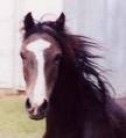
The development of the Hackney breed matched, stride for stride, the improvement in both the quality of life and the use of public roadways in Britain. Prosperous farms, not nobility, were responsible for developing this high-tech carriage and riding horse. As noblemen were busying themselves with fox-hunters and Thoroughbred race horses, the wealthy farmers took to the roads to show off the tangible fruits of their labors. A pair of perfectly matched bays with elegant head carriage, trotting along smartly, their knees rising almost to their noses...ah, that was the proof of abundant crops, calves and lambs.
The origins of the Hackney as we know it began in Norfolk, England where the horses called Norfolk Trotters had been selectively bred for elegant style and speed. Seeking to improve on both counts, breeders mated the Norfolk mares to grandsons of the foundation sires of the Thoroughbred. The first Hackney as we know the breed today is said to be The Shale’s Horse, foaled in 1760. During the next 50 years, the Hackney was developed as a special breed.
Haflinger
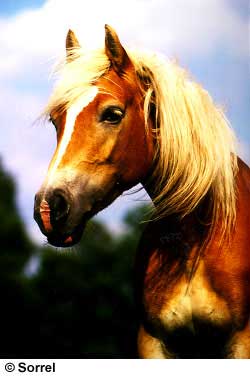
The Haflinger is an old breed of small horse that originated in the mountains of the Austrian Tyrol. The name comes from the village of Hafling, part of Austria prior to the end of World War I, but now, located in Italy. The beginning of today's Haflinger can be traced to the year 1874 and the birth of the stallion, "249 Folie," out of a refined, native Tyrolean mare and sired by the half-Arab stallion, "133 El' Bedavi XXII." All purebred Haflingers trace their lineage to this stallion.
The Haflinger came to North America in 1958. Tempel Smith of Tempel Farms, Wadsworth, Illinois, imported them from Austria to begin a breeding program along with his imported Lippizzan horses. Others soon began importing Haflingers, and today there are a number of importers and breeders throughout the United States and Canada. While Haflingers are imported from Germany, Holland, England, and Italy, most continue to come from Austria.
Hanoverian

The Hanoverian is a noble, correctly proportioned warmblood horse with natural balance, impulsion and elegant, elastic movements characterized by a floating trot, a round rhythmic canter, and a ground-covering walk. The breed's historic home is in today's state of Lower Saxony, in northern Germany, the former Kingdom of Hanover where a flourishing horse-breeding industry has existed for 400 years. The Hanoverian has dispersed to all five continents and represents today one of the most prominent breeds of riding horses in the world.
What special attributes make the Hanoverian so valuable as an all-around riding and a performance competition horse excelling in many different disciplines?
Holsteiner
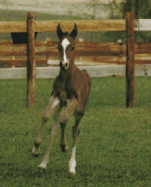
The Holsteiner horse is the product of systematic breeding that has been ongoing in the northermost province of Germany, Schleswig-Holstein, for 750 years.
Originally the horse was valued by German farmers for his strength, steadiness and reliability, and by the military for his courage and agility. The age of mechanization and conditions in post war Germany necessitated a new direction for the breed. The Holsteiner developed into one of the great German sporting horses, particularly suited for jumping, dressage, driving and eventing. This was accomplished through careful infustion of English Thoroughbred and Anglo Norman blood which added elegance, refinement and jumping ability to the superior character of the Holsteiner foundation stock.
The modern Holsteiner is of medium frame and stands 16 to 17 hands with a powerful hind lag, strong back and loin. His arched neck rises from a well angled shoulder to a small head with a large intelligent eye. This conformation adapts easily to "self-carriage" - that expressive, elegant movement so essentail in dressage, driving and jumping.
Icelandic

The first breed societies for the Icelandic were formed in 1904 with the first register being formed in 1923. In the early 1900's the Icelandic horse was used extensively in Iceland for transportation and travel and as a working horse. In the 1940's and 50's its role was coming to an end but it has now been rediscovered in its native country and is recognized as a unique sport and family horse.
The Icelandic horse is described as a rather small, sturdy and hardy, but not light in build and thus often lacking in elegance. But the strong characteristics of the breed are said to be the versatility in riding performance, lively temperament and strong but workable character. Traditionally the Icelandic horse has been raised free range or in a herd which no doubt is part of the reason for these strong characteristics. The average height is between 13 and 14 hands with an average weight of between 330 and 380 kg. All colors are found except appaloosa marking, with the most common being chestnut. All white markings are acceptable and there are pinto in all of the base colors. The horses have long, thick manes and tails and the winter coat is double. The appearance of the Icelandic horse in countries outside of Iceland has changed somewhat due to upgrading programs used during the 1950's
Jutland
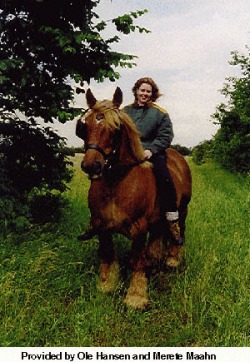
The Jutland is Denmark's own breed of heavy horse. Its ancestors have been bred on the Jutland peninsula since the middle ages and before. Selection for the breed as it appears today began around 1850. One of the greatest contributions to the success of the breed came from the stallion Oppenheim who was imported from England in 1862. Oppenheim was Shire and Suffolk. Six generations later the stallion Aldrup Menkedal, who is considered the foundation stallion of the breed, was born. Almost all Jutland breeding can now be traced back to Hovding and Prins af Jylland, two of his sons.
Beginning in 1928, there has been a close association between the Jutland breed and the Carlsberg brewery which uses Jutlands to haul brewery wagons. At one time there were 210 Jutland horses with Carlsberg and today about twenty are still used for beer transportation in Copenhagen. The Carlsberg horses take part in many shows, festivals and films, promoting both the breed and the brewery.
Kabarda
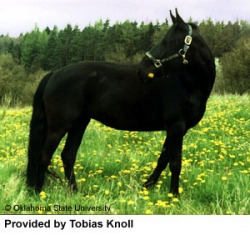
This is a native North Caucasian breed found mainly in the Kabardino-Balkar Autonomous Republic and in the foothills area of Stavropol territory. In the process of its formation the Kabarda was influenced by many breeds - steppe horses, the Karabakh, the Persian and the Turkmenian. Kabarda horses are kept in taboons and transferred to mountain pastures in summer and to the foothills area in winter.
The Kabarda is primarily a saddle horse. The bulk of the horses are not large. Their average height ranges from 145 to 152 cm. However, the measurements (in cm) of stallions at studs were as follows: height at withers 155, oblique body length 153, chest girth 180, cannon bone girth 20. The Kabarda has a solid clean build. Its conformation may be described as follows: head - clean, sometimes coarse, ram profile, with long ears and usually a short poll; neck - medium-long, straight and well muscled; medium-high and long withers; straight, short and solid back; well-muscled loin; slightly sloping and heavily-muscled croup; medium-long and correctly-sloping shoulders; deep and long-ribbed chest; correctly-set legs, hindlegs often bowed; well-developed clean joints; hard hoofs. Although the Kabarda has only a moderate hair coat its mane and tail may be quite thick and legs may have feather on the fetlocks. Predominant color cherry bay, often bay brown; black is rare.
Kiger Mustang

For decades it was largely accepted that the Spanish bloodlines from which the Mustangs of the American west had descended were either lost or very diluted in the current day Mustangs. However, some people speculated that there might be isolated herds of horses which would still have a strong Spanish influence. In 1977, a herd of mustangs which appeared to be largely of Spanish descent were brought in from the remote and rugged Beaty Butte region in Lake County, Oregon. The animals were uniformly of a dun coloration, ranging from brown-dun to nearly white. All had dorsal stripes and zebra striped legs. Two subsequent groups were gathered from the same area and were equally uniform in size and color. The Kiger Mustang shows the classic Barb head and the right size with an average weight of between 700 and 800 pounds.
Steps were taken immediately to preserve these unique horses. The herd was split in two with 20 animals being released on the East Kiger Herd Management Area and the remaining seven turned out on the Riddle Mountain Herd Management Area, about five miles to the northeast. To prevent contamination of the breeding stock measures were taken to make certain there were no other horses in either area .
Latvian
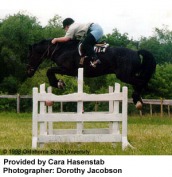
The Latvian breed was developed in Latvia from the beginning of the 20th century up to 1952 by crossing the native horses with west European harness and harness-saddle breeds. Oldenburg, Hanoverian and to a less extent Holstein stallions had most influence. Between 1921 and 1940, 65 Oldenburg stallions and 42 Oldenburg mares were imported from the Netherlands and Germany; they became the core of the breed. Besides the purebred Oldenburgs, Oldenburg crosses and Hanoverian, Norfolk Roadster, Ardennes and East Friesians were widely used. A special role in breed formation was played by the Okte stud in the Talsa region. Two types, the harness horses and the equestrian sports horses, have been evolved. Prior to 1960, the harness type was emphasized. Subsequently, as mass scale equestrian sports developed in Latvia on a large scale, the number of horses of the sport type was increased through infusion of the Hanoverian and, to a less extent, Thoroughbred blood. The modern Latvian is a successful combination of the features of the utility and saddle horses. Tall, heavy muscled and bony, in format they are intermediate between saddle and harness horses. Latvians have a well-proportioned and solid build; the joints are sometimes coarse. Muscles are well developed, bone structure solid, chest broad, withers moderately pronounced or high and long and with a normal slope, legs properly set and with well-developed knee-joints and hocks. Defects include short and ringboned pasterns and cow hocks. The commonest colour are bay, brown and black; chestnut is less frequent
Lipizzaner

The Lipizzan (or the Lipizzaner as it may sometimes be called) trace their history back to the early 1560's when the finest Arab blood was introduced and fused with the local athletic Spanish horses during the Moorish occupation of Spain. Interest in the art of classical riding revived during the Renaissance period when the Spanish horse was considered the most suitable mount because of his exceptional sturdiness, beauty and intelligence.
Maximillian II brought the Spanish horses to Austria about 1562 and founded the court stud at Kladrub. His brother, Archduke Charles established a similar stud with Spanish stock in 1580 at Lipizzaner in Slovenia near the Adriatic Sea. From the Lipizza stud farm, came the name Lipizzan. Both studs flourished, the Kladrub stud became known for its heavy carriage horses while the Lipizza stud produced riding horses and light carriage horses. However, the two studs were linked closely and on occasion exchanged breeding stock. The Kladrub stud produced Maestoso and Favory, two of the foundation sires of today's Lipizzan
Mangalarga

The Mangalarga Marchador, originating in Brazil in the south of the state of Minas Gerais, has, as the true expression of the breed, the "marcha". This is an accelerated gait that maintains regularity making the ride very smooth and comfortable for the rider. It originated in the mid-19th century from Alter and Brazilian native. A breed society was formed in 1934. Varieties include Marchador or Mineiro (Minas Gerais) and Paulisto (São Paulo). The Paulisto is lighter, leggier and of more recent development.
During the "marcha", the Mangalarga Marchador makes a semicircle with the anterior members and uses the posterior members as leverage, thus propelling the animal forward. When in movement the Mangalarga Marchador executes an alternation of diagonal and lateral supports, always softened by an intermediate time: the triple support. This is the movement when three of the horses hooves touch the ground at the same time.
Minature Horse

The American Miniature is a "height" breed; they must measure no more than 34 inches in height at maturity. This measurement is the vertical distance from the last hairs at the base of the mane to the ground. These tiny equine are replicas of their larger breed cousins and will look like Quarter Horses, Arabs, Thoroughbreds, and Draft Horses.
The American Miniature Horse Association's Standard of Perfection calls for a small, sound, well-balanced horse, possessing correct conformation characteristics. These horses are not dwarves, runts, or "genetic" errors, but are produced by selectively breeding down in size yet maintaining as near-perfect conformation as possible.
Miniature Horses thrive on attention and display a curiosity and intelligence that make them delightful companions, allowing people of all ages to enjoy them. People who find that they can no longer handle the 1,000 pound-plus horse do not have to give up their passion for horses, they may simply switch over to the smaller animal. Those who have never experienced that very special thrill of ownership, yet always wanted to, are finding that the "mini" is a wonderful opportunity. These little horses have already proved their worth in therapeutic programs for the disabled child or adult, as well as with the aged. People in high-pressure jobs find them to be a wonderful aid in relieving stress.
Mongolian

The Mongolian horse is one of the most important and numerous breeds found among the indigenous horse breeds of China. They are distributed widely throughout the Northeast, North China and the Northwest, mainly in the high plains and highland areas. It is a dual-purpose horse, used primarily for riding and carting, but is also used for meat and milk production. The average wither height of males is 128 cm, females 127 cm, but body size varies with environmental conditions.
Morgan

Justin Morgan was a living legend. In the manner of so many heroes, he began as an unremarkable colt and became the father of an entire breed of horses recognized for quality and dependability.
Born in 1789, Justin Morgan started life as a small, rough-coated colt known as "Figure." In 1791, he left his birthplace in Springfield, Massachusetts with his new owner, the soft-spoken schoolteacher Justin Morgan, by whose name the stallion eventually became known. Although his breeding was unknown (thought to be of Dutch, Thoroughbred, or Arabian breeding), the quality of Justin Morgan's ancestry showed in his straight clean legs; deep muscling over his quarters and shoulders; and fine, intelligent head with large expressive eyes and short, pricked ears. Add to these the quality of his movement, a thick but silky mane and tail, and a clean-cut throatlatch, and you have the conformation of the ideal light horse. Despite these fine qualities, Justin Morgan's lack of size was such that his debt-ridden owner found no buyers on their journey north to Randolph Center, Vermont. It was simply fate that no one but, his new owner realized what a little giant he was
Mustang
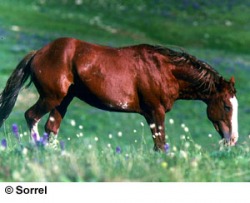
The Mustang is a feral horse found now in the western United States. The name Mustang comes from the Spanish word mesteño or monstenco meaning wild or stray. Originally these were Spanish horses or their descendants but over the years they became a mix of numerous breeds. These were the horses which changed the lives of the Native Americans living in or near the Great Plains. As European settlers came farther west they brought their horses with them. Some were lost to Indian raids, others were freed as wild stallions tore down fences to add the tame mares tn his herd or tame horse escaped from settlers as the original horses had escaped from the Spanish. Draft breeding was among the horses which added to the Mustang herds. Also the Indians bartered and captured horses between tribes, making the distribution more complete.
Herds of wild horses from the eastern United States were forced west by civilization and eventually crossed the Mississippi River and joined the western herds. French blood was introduced to the mix from herds pressured out of the Detroit area and from French settlers in the South in the region around New Orleans.
Another breed that probably contributed to the blood of the Mustang is the old-type East Friesian. For a period of over 10 years during the late 1800s and early 1900s about 150 stallions each year were purchased by the U.S. government from Germany. The old-style East Friesian of that time was a heavy warmblood or coach horse and was purchased to pull artillery or heavy wagons. So wherever the US calvary was found in battles in the west these horses were found, and undoubtedly some escaped and added their blood to that of the American Mustang.
The large herds of wild horses did not pose a particular problem until the western United States became settled and cattle and other grazing animals were added to the native range. The arid lands of the west could not support a large population of grazing animals and on some ranches it became the policy to shoot Mustangs. The population of Mustangs at the beginning of the twentieth century is estimated at two million. By 1926 the population had been halved. The current population varies but is near 30,000. In 1971, Congress passed the Wild Free-Roaming Horse and Burro Act which protected these animals. The Department of the Interior, through the Bureau of Land Management (BLM) and the Department of Agriculture, through the Forest Service, have the responsibility of administering this law.
New Forest Pony
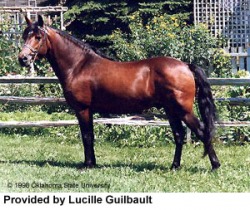
\Named for the forest in southern England, where this breed originated, the New Forest pony is one of the recognized breeds of mountain and moorland ponies of the British Isles. They are noted for intelligence, strength, versatility and a quiet, willing-to-please temperament. Of all the native British pony breeds, New Foresters are the least afraid of man.
New Forest ponies range -in size up to 14.2 hh and while there's no official lower limit, they seldom go below 12 hh. Bay, brown and grey are the most prominent colors and chestnuts, roans and blacks are also seen. Limited white markings are allowed on the head and legs. (Blue-eyed cream, piebalds and skewbalds are not permitted).
Oldenburg
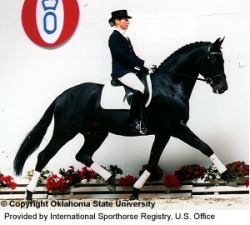
Of all the horses registered with the German Equestrian Federation in 1987, approximately 8 percent were Oldenburgs. The Oldenburg registry represents one of the top lines in Germany. The percentages are somewhat skewed as to Oldenburgs, due to the fact that the region in which these horses are bred is a small one and therefore produces fewer absolute quantities of horses than other registries. While representing the smallest breeding area in Germany, Oldenburg is nevertheless one of the most important.
The Oldenburg is bred in a small area near the modern region of Lower Saxony surrounding the city of Oldenburg, a breeding area historically confined to approximatively 5,400 square kilometers, in the center of the Hannoverian region. The average breeder is a farmer with from 20 to 100 hectares of land and two to four registered breeding mares. The breed, also found in East Friesland, can be traced back to the 17th Century, with bloodlines based on the Friesian horse.
Paint

Let your imagination carry you back to a simpler time. A time when wide open spaces under clear, crisp skies beckoned to come explore the wild frontier. Rediscover those basic values and simple pleasures on the back of a colorful horse. Celebrate this chance to return to the roots of the American West with a unique, living legend - the American Paint Horse.
Decorated by nature, the origins of the Paint Horse in North America can be traced back to the two-toned horses introduced by the Spanish explorers, descendants of horses from North Africa and Asia Minor. Inevitably, some of these colorful equines escaped to create the wild herds of horses roaming the Great Plains. Captured and gentled, they raced alongside the vast herds of buffalo and traveled hundreds of miles on cattle drives. Cherished by the finest horsemen of the Western frontier, both Native Americans and cowboys sought the hardy horses loudly splashed with color.
Over time, breeders gradually improved the conformation and athletic ability of the rugged descendants of wild mustangs and cow ponies. Each generation passed its unusual and unique coat patterns and coloring to the next, creating the American Paint Horse. Today, the stock-type conformation, natural intelligence and willing disposition make the American Paint Horse an ideal partner for pleasure riding, showing, ranching, racing, rodeoing, trail riding, or just as a gentle friend for the kids.
Paso Fino
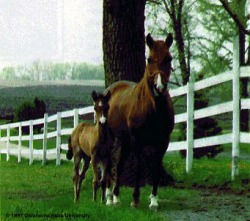
The history of this noble animal began in Spain where the chance mix of breeds sparked the seed that became one of the world's finest riding horses. Moorish occupation of the Spanish countryside brought with it the Berber horse, also known as the Barb, an animal that had a strong genetic impact on equine development throughout Europe, North Africa, and the New World. Interbreeding with native stock produced the delicately gaited Spanish Jennet. They were subsequently bred with the Andalusian.
Just as the Moorish conquest of Spain introduced a potentially promising breed to that country, so it was with Columbus' second voyage to the New World, when he transported the first horses to Santo Domingo - now the Dominican Republic. These animals were a mix of the Berber, the Jennet and the Andalusian. Future voyagers would add to their numbers in Mexico and South America, but the overall isolation established these as the ancestors to the Paso Fino.
As remount stock for the conquistadors, the progeny of these horses were dispersed throughout the lands attacked by the invaders. The early fifteen-hundreds saw famous and infamous explorers and conquerors such as Martin de Salazar, Diego de Velasquez, and Hernando Cortez transport horses to Puerto Rico and Colombia, as well as Cuba, the Isthmus of Panama, and Mexico.
Percheron
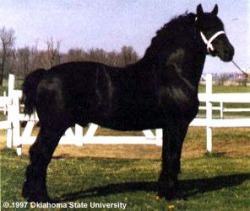
The exact origins of the Percheron have been lost over time. Some believe they are descendants of the original horses found in the region during the Ice Age, others that he is closely related to the Boulonnais horse used in the Roman invasion of Brittany. Still others believe the breed is from Abd el Rahman's Arab stallions or part of the horses used by the invading Moors at the battle of Poitiers which were divided among the victorious French forces. Regardless of these ancient beginnings it is known that at two points in history the native mares of the Le Perche region of France were mated with Arab stallions, first during the eighth century and later during the Middle Ages. By the time of the crusades the Percheron was widely recognized as outstanding for his substance and soundness, as well as for his characteristic beauty and style.
By the 17th century horses produced in Le Perche had attained widespread notoriety and were in demand for many different uses. The Percheron of this time showed less scale and was probably more active. He stood from 15 to 16 hands high.
Peruvian Paso
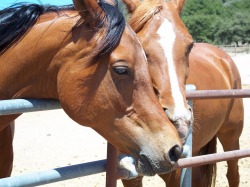
Prior to the seventeenth century, most of the world's horses were naturally gaited. Horses that trotted were the exception, and "Boneshakers" as they were called were considered suitable only as pack animals or mounts for servants. Almost all traveling was done on horseback. Since most people knew very little about riding, a smooth riding horse was a necessity. Even Knights - who required trotting horses for battle - often kept a naturally gaited horse which he would ride when traveling, leading his trotting horse behind.
Following the seventeenth century, the uses for trotting horses increased. Networks of roads were built, and people began to travel by horse-drawn vehicles rather than on horseback. Since a horse that trots is more suitable than a gaited horse for pulling a wheeled vehicle, the breeding of trotting horses was increased at the expense of gaited horses. At about the same time, great expanses of land were devoted for the first time to cattle raising, and the horse took on importance as a tool for working the cattle. Here again the trotting horse has a greater advantage over the gaited horse, and even more emphasis was put on the breeding of horses that trotted. Almost simultaneously, worldwide popularity was bestowed upon horse racing, yet another activity where gaited horses do not excel.
As the seventeenth century opened, it was unusual to see a horse that trotted. At the close of the same century, it was unusual to see a horse that did not trot. It was one of the most unusual transformation that horse breeding has ever seen.
As the world's horsemen moved from naturally gaited horses to trotting horses, the Peruvians continued to esteem and breed their naturally gaited "Caballo Peruano de Paso". The Peruvian Paso horse descended from the bloodstock which was introduced to Peru from the Spanish, who at the time were the foremost horse breeders in the world. The Spanish horses brought to Peru blended the Barb, the Friesian, the Spanish Jennet, and the Andalusian. In Peru these Spanish horses were bred to produce the purest link that the modem world has with the once populous gaited horses. For several centuries, no outside blood has been introduced into the Peruvian Paso breed, and it is now the only naturally gaited breed in the world that can guarantee its gait to 100% of its offspring. Every purebred Peruvian horse has the inherited gait, which is the trademark of the Peruvian breed.
Pony of the Americas (POA)

The Pony of the Americas is a popular and growing breed. It was begun in 1954 to provide a pony with good appearance, speed, and stamina for young riders who were too big for a small pony but not ready for a full-sized horse. The Pony of the Americas is a distinctive breed of pony possessing the attractive coloration of Appaloosa Horse. The POA is a rugged, athletic pony with the speed for games and jumping and the intelligence and patience for showmanship and equitation. Small size makes it easy for parents to match a child to a pony. The POA's great disposition makes them highly competitive in all horse circles. The Pony of the Americas has a refined head with a dished, Arab-like nose, expressive eyes and fine ears. The body is full, the chest broad, and the shoulders should be sloping. The quarters are substantial, and the legs should have ample bone. The POA is a strong, fast, and durable pony capable of performing a wide variety of tasks. The POA exhibits a variety of colorful coat patterns from blankets to leopard spots. The modern POA has the appearance of a small horse.
Przewalski
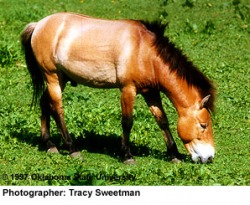
The Przewalski horse (Equus przewalski poliakov) is the last remaining wild species of horses. All other horses are either domesticated or descended from horses which were once domesticated. Until the mid-1990's the Przewalski was extinct in the wild, exterminated by hunters. Through efforts of the Przewalski Foundation in the Netherlands and breeding preserves in Askania Nova, Ukraine, in 1992 two combined breeding groups of Przewalski horses were reintroduced to Mongolia with the ultimate plan to reintroduce the animals to the open steppe.
It was originally believed that the Przewalski horse was discovered by the Russian explorer Colonel Przewalski, for whom it is named, in 1881. More recent information from the Przewalski Horse Foundation indicates two Europeans saw these animals much earlier. A Scottish doctor who was sent on an embassy to China by Peter the Great wrote of his experiences in Journey from St. Petersburg to Pekin, 1719 - 1723 and included an accurate description of this Asiatic Wild Horse. Even earlier, Hans Schiltberger, a Bavarian nobleman, was taken prisoner by the Turks and sold to the famous Tamerlane of the Golden Horde, who in turn gave Schiltberger to a Mongol prince named Egedi. Schiltberger spent several years in the Tien Shan mountains. He wrote of the wild horses he observed in his memoirs "Journey into Heathen Parts". The unpublished manuscript was written in 1427 and is housed in the Munich Stadtbibliotek (municipal library).
Quarter Horse

The principle development of the Quarter Horse was in the southwestern part of the United States in Texas, Oklahoma, New Mexico, eastern Colorado, and Kansas. Some breed historians have maintained that it is the oldest breed of horses in the United States and that the true beginning of the Quarter Horse was in the Carolinas and Virginia. Nye1 has suggested that the Chickasaws secured from the Indians were the true beginning of the Quarter Horse. These were small blocky horses, probably of Spanish extraction, which the planters secured from the Indians, and which were adapted for a variety of uses. The colonists were quite interested in short races, and it was only natural that they should have attempted to increase the speed of their horses; to this end some of the best early Thoroughbreds that were brought to the United States included the horse Janus, brought to the United States before the English Stud Book was established, were instrumental in the improvement of these local running horse. Later Imp. Sir Archy and other Thoroughbred stallions were used.
The early improvement in the Quarter Horse-so called because of its great speed at one quarter of a mile-and the early development of the Thoroughbred in the United States were closely associated. Some sires contributed notably to both breeds. Many short-distance horses were registered in the American Stud Book as Thoroughbreds when the Stud Book was established, even though they did not trace in all lines to imported English stock.
It is more logical to assume that the true establishment of the Quarter Horse took place some time later in the southwest range country, rather than in colonial times. It was in the southwest that the true utility value of these short-distance horses were truly appreciated. The cowman found the Quarter Horse quick to start, easy to handle, and of a temperament suitable for handling cattle under a wide variety of conditions. Even in the Southwest much was unknown of the breeding of many of the horses that were classified and registered in the 1940s as Quarter Horses. It is logical, therefore, to conclude that until the Stud Book was established and the pedigrees were based on fact rather than on memory and assumptions, the Quarter Horse should have been called a type of horse rather than a breed.
Rocky Mountain Horse
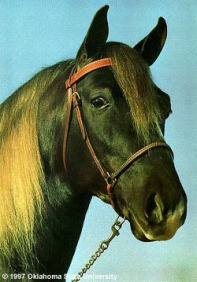
Tradition has it that around the turn of the century a young horse appeared in eastern Kentucky that gave rise to a line of horses that has been prized and treasured in this part of the country ever since. The basic characteristics are of a medium-sized horse of gentle temperament with an easy ambling four beat gait. This gait made it the horse of choice on the farms and the rugged foothills of the Appalachians. It was a horse for all seasons. It could pull the plows in the small fields, work cattle, be ridden bareback by four children to the fishing hole, or to town comfortably on Saturday. They even performed well hitched to the buggy Sunday morning to go to church. Fancy barns and stalls were not necessary. Because of its cold blooded nature, it tolerated the winters in Kentucky with a minimum of shelter. For these reasons, in small groups, the breed was preserved, sustained and gradually increased in this area. Naturally, out crossing with the local horses did occur but the basic characteristics of a strong genetic line have continued. In Spout Springs, Kentucky, on the farm of Sam Tuttle, these horses found a nurturing ground. Sam, who had the concession for horseback riding at the Natural Bridge State Park, used these horses for many years to haul green and inexperienced people over rough and rugged trails. Old Tobe, his most treasured stallion, who fathered fine horses up until the ripe old age of 37, was as "sure” footed and as gentle a horse as could be found. He was the one that carried the young, the old, or the unsure over the mountain trails of Kentucky, without faltering, even though a breeding stallion. Everyone who rode the stallion fell in love with him. He had the perfect gait and temperament. Many of the present Rocky Mountain Horses® carry his bloodline. The breed is known for gentleness. It is an easy keeper and a wonderful riding horse with a strong heart and endurance. Today the Rocky Mountain Horse® is being used as a pleasure horse, for trail, and competitive or endurance riding. As show horses the breed is rapidly gaining in popularity because of its beauty and unique way of moving in the ring. The calm temperament of this horse makes it ideally suited for working around cattle and for 4-H projects. These horses have a lot of natural endurance, they are sure footed on rough ground and, because of their gait, they require a minimum of effort by both horse and rider so that together they can cover a greater distance with less tiring.
Russian Heavy Draft

The breeding of a small draft horse which was strong, sufficiently fast, easy to keep and economical as regards management and feeding, went on in Russia concurrently with the breeding of a large heavy draft breed. The genetic material for the breed came from native Ukrainian breeds, the mountain Ardennes and, in part, from the Brabancon and the Orlov Trotter.
Systematic breeding began in the 1860s. The main nucleus of the breed was formed at Peter's Academy (now the K. Timiryazev Moscow Agricultural Academy), Chesma stud in Voronezh region, at Kochubei and Chaplits studs in Poltava region and Derkulski stud in the Ukraine. Meanwhile, grading up of native horses with the Ardennes was taking place. In 1875 there were nine Ardennes stallions in Russia; the number rose to 597 by 1915. By the beginning of the 20th century the Ardennes type became the most popular in Russia. Even in regions where there was a demand for large heavy drafts and were high grade Ardennes were mated with Brabancons, the crosses retained the old denomination of Ardennes. During the breed formation period, a role of particular importance was played by two breeding centers, the Chesma and the Dubrovsk, and subsequently by the Pershino and Khrenov studs. By the beginning of the 20th century, the world's zootechnical public was introduced to the Russian Heavy Draught at the 1900 Paris Exhibition. However, the First World War, followed by the Civil War, just about wiped the breed out. In 1924, only92 Ardenne stallions were found. In 1923, breeding animals at Dubrovsk stud were moved to Novoalexandrov stud in Voroshilovgrad region, while the Khrenov stud stock was moved first to Pershino and subsequently to Uralsk and Kuedin studs. By the year 1937 the stock of purebreds was reconstituted and isolated an independent bre
Saddlebred
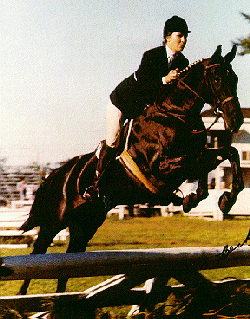
Paul Revere's famous ride was a Narraganset Pacer, a breed which was important in the development of the Saddlebred.
Also, in the Revolutionary War, American cavalry decisively defeated British regulars at King's Mountain, South Carolina. These farmers and frontiersmen were mounted on American Horses.
American Horses accompanied pioneers following Daniel Boone through the Cumberland Gap into Kentucky. These animals were seed stock, making Kentucky a major horse producing state.
In the War of 1812, similarly mounted Kentuckians ranged from Michigan to Illinois to fight the British and their Indian allies.
After that war, the production of good Saddle Horses became a priority in Kentucky. These animals played a major role in the settlement of the upper Ohio Valley. They went south into Tennessee and beyond, and across the Mississippi into Missouri. Animals from Ohio, Indiana, Illinois, Iowa, and Tennessee all made contributions to the breed. Missouri rivaled Kentucky for the best Saddle Horses and Missourians say, "If Kentucky made the Saddle Horse, then Missouri made him better."
Selle Francais
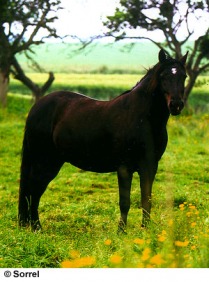
The Selle Francais is the epitome of what a sport horse should be, athletic, strong, good bone and muscle, intelligent with a tractable disposition. Primarily known for its excellence in show jumping, the versatile Selle Francais also excels in dressage and eventing.
Through an intensive and aggressive breeding program, the French have, over the past several decades, created this extraordinary breed by selectively crossing their sturdy native horses with Thoroughbred stallions. Judicious introduction of the French AngloArab and French Trotter has added brilliance, agility and energy to the breed. The North American Selle Francais Horse Association, Inc. (NASFHA) was authorized in early 1990 by the French National Stud to register Selle Francais and other French breed horses born in North America. Additionally, NASFRA facilitates an annual inspection of breeding stallions, provides information to promote the breed to the general public, and assists breeders with specific pedigree information.
Shetland Pony
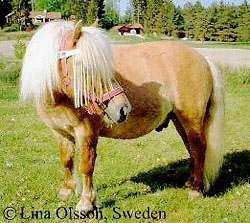
Perhaps the oldest breed of horse in Britain is the Shetland Pony. Named after the islands where it originated, it is now one of the most popular ponies in the world. The little Shetland is probably so shaggy because it was conditioned by its environment. The Shetland Islands, lying off the northern coast of Scotland, are mostly barren and have a harsh climate. For many centuries the Shetland Pony lived in the open, protected from the elements only by this thick hair, long mane, and forelocks. The Shetland Islanders domesticated the ponies to do useful work for them. The pony carried peat down from the bogs to the cottages for use as fuel. They also hauled seaweed up from the shore to the fields to be used as fertilizer.
Shire
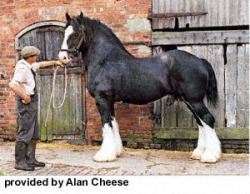
The origin of the Shire breed is lost in the mists of antiquity, as is the case with many breeds, but we do have a pretty fair notion from whence he cometh.
Sir Walter Gilbey, an early authority on the breed, had this to say on the introduction to Volume 1 of the stud book.
"The Shire horse is the purest survival of an early type which was spoken of by medieval writers as the 'Great Horse.' If this horse did not originate in England, this country at a very early date acquired a widespread reputation for producing it. Indeed, the English 'Great Horse' seems to have been a native development of that British 'War Horse' whose strength, courage and aptitude for discipline are spoken of in high terms by the -chroniclers of the Roman legions at their first landing upon these shores.
Spanish Mustang
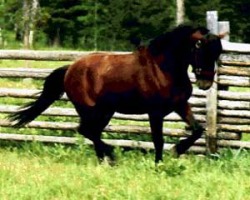
In the mid-1950's a group of dedicated men met to form an organization for the purpose of preserving the last of the true, old-type Spanish Mustangs, a breed that once roamed the western part of the United States in great numbers but was now threatened with extinction. The efforts of Robert E. Brislawn of Oshoto, Wyoming, were the primary moving force that brought this group together.
To preserve the breed, Brislawn collected individual animals that he considered the best examples of the breed. He chose his stock carefully, culling out those he believed less than ideal.
Standardbred
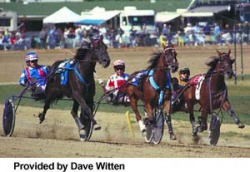
The Standardbred horse is considered to be the fastest harness horse in the world. Harness racing has been a passion in the United States since the early 1800's. Then, the Morgan horse reigned as the supreme harness horse. But an event occurring in 1849 ended the Morgan Dynasty. This event was the foaling of a horse named Hambletonian 10, the foundation sire of the Standardbred horse. The breed gains its name from the fact that a horse must meet a certain "standard" of either timed speed at the mile or breeding in order to be properly registered. The increased brilliance of the Standardbred breed itself has reduced times for the mile by a minute -- down 30 percent from the original record. In many respects the Standardbred resembles its ancestor the Thoroughbred. It does not stand as tall, averaging 15.2 hands, although it has a longer body. The head is refined, set on a medium-sized neck. The quarters are muscular yet sleek. The clean hind legs are set well back. Individual Standardbreds tend to either trot or pace. This breed appears in varying colors, although bay, brown, and black are predominant. It weighs between 800 and 1000 pounds.
Swedish Warmblood
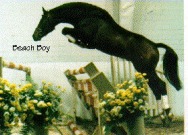
Elegance, combined with excellent gaits and a positive attitude, jumping ability and capacity to absorb training make the Swedish Warmblood (SWB) well suited for international equestrian sports, and dressage in particular. Swedish horses have been medalists in virtually every Olympiad since 1912, most often in dressage, but also in combined training. In the 1988 Seoul Games, 13 Swedish Warmbloods participated in dressage and 6 won medals. In the 1960 Rome Olympiad, the stallion Drabant had six sons participating. The versatility of the SWB horse was proven by Thomas Eriksson when he captured the individual gold medal in four-in-hand combined driving at the World Equestrian Games in 1990.
Tennessee Walking Horse

Over one hundred years ago, in the Middle Basin of Tennessee, a unique breed was created - the Tennessee Walking Horse. The early settlers of this region who came from Virginia, the Carolinas and other surrounding states, brought with them fine Standardbreds, Morgans, Thoroughbreds, Canadian and Narrangansett Pacers. By combining the traits of these great horse families, the foundation was laid for the Tennessee Walker who developed distinctive qualities of its own.
The most prominent characteristic of Tennessee Walkers is their swift and smooth "running walk." This gait is inherited and cannot be taught to a horse who does not possess it naturally. It is a square four-beat gait with a gliding motion, and a bobbing of the head and swinging of the ears accompany each step. Some Walkers are even known to snap their teeth in time. When performing the running walk, these horses will overstride, placing the back hoof ahead of their forehoof print. Traveling at speeds from 6 to 12 miles per hour, Walkers can sustain this gait for long distances without fatigue to themselves or their passengers.
Tennessee Walkers are also known for two other gaits. They are the "flat-foot walk" which is a slow, bold, and even gait; and the “canter" which is a refined gallop with a slow and high rolling motion. The canter is full of spring, rhythm and grace, and is often referred to as the "rocking chair gait.” All three gaits of the Tennessee Walker are extremely easy on the rider.
Thoroughbred

The term Thoroughbred describes a breed of horse whose ancestry traces back to three foundation sires -- the Darley Arabian, the Godolphin Arabian and the Byerly Turk.
Named after their respective owners -- Thomas Darley, Lord Godolphin and Captain Robert Byerly -- these three stallions were brought to England from the Mediterranean Middle East around the turn of the 17th century and bred to the stronger, but less precocious, native horse.
The result was an animal which could carry weight with sustained speed over extended distances, qualities which brought a new dimension to the burgeoning, aristocratically-supported, sport of horse racing.
So began a selective breeding process which has been going on for more than 250 years, breeding the best stallions to the best mares, with the proof of superiority and excellence being established on the race track.
Trakehner
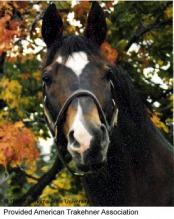
The Trakehner is a European warmblood horse of East Prussian origin, the foundation for which was laid at the main stud farm established in Trakehnen, East Prussia in 1732. The breed's name is derived from this world-famous farm, and the bloodlines can be traced back to this source. At the beginning, the horse was a stocky, strong native animal which needed size and refinement. The really important and decisive development of the breed, therefore, occurred in the early 1800's when top quality English Thoroughbred and Arabian blood began to be introduced in small quantities. The goal of the breeding programs then became directed toward breeding a better endurance horse which would prove himself not only highly efficient as a riding horse during wartimes, but also as a working horse on East Prussian farms during times of peace. The object, ultimately, was to add the size, nerve, spirit and endurance of the Thoroughbred to the bulk, stability and nobility of the native breed. Further refinement in the breed came with the addition of Arabian blood.
Welsh Pony

The original home of the Welsh Mountain pony was in the hills and valleys of Wales. He was there before the Romans. His lot was not an easy one. Winters were severe. Vegetation was sparse. Shelter, most often, was an isolated valley or a clump of bare trees. Yet the Welsh pony managed not only to survive, but to flourish.
Led by proud stallions, bands of mares and their foals roamed in a semi-wild state, climbing mountains, leaping ravines, running over rough terrain. This sort of existence insured perpetuation of the breed through only the most hardy of stock. Hence, the development of a pony with a remarkable soundness of body, a tremendous endurance, and a high degree of native intelligence.
Even an edict of Henry VII that all horses under 15 hands be destroyed did not eliminate the Welsh. Hiding in desolate areas where his persecutors were reluctant or unable to go, perhaps at Nant Llwyd, he continued to live and reproduce, preserving for mankind a distinctive strain of pony that today has generated enthusiasm among breeders and pony lovers all over the world.
Down through the years, the Welsh pony has served many masters. There is evidence to support the belief that he pulled chariots in vast sports arenas. He has worked in coal mines, on ranches, and on postmen's routes.
Yonaguni
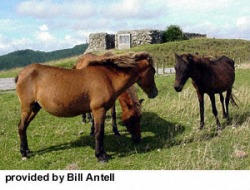
The Yonaguni is a small native pony of the southwest islands of Japan. In 1996 there were about seventy-five living Yonaguni ponies on East and North Ranches on Yonaguni Island, located on the west side of the Yaeyama Islands.
Little is known about the origin of the Yonaguni. Horses in Japan can generally be divided into two groups, larger specimens from Hokkaido and smaller individuals from Yonaguni. Many people believe that the small horses were introduced from the southern islands during the Jyomon Period, about two thousand years ago. Professor Ken Nozawa of Kyoto University claimed in 1983 that the gene characteristcs of the breed indicated relationship to the Cheju breed in Korea.
